If your child has been diagnosed with a CMPA allergy (Cow’s milk protein allergy), or you think they might have CMPA, you might be feeling overwhelmed right now. Don’t worry, we’re here to help! In this blog post, we’ll give you all the information you need to know about CMPA including symptoms, diagnosis, and treatment options.

Table of Contents
What is a CMPA Allergy?
Cow’s Milk Protein Allergy (CMPA) also commonly referred to as Cow’s Milk Allergy (CMA) is a reaction by the immune system to one or more proteins found in cow’s milk. When you have a CMPA and consume cow’s milk or other dairy products, your immune system registers the proteins as harmful and releases histamine. The proteins that most commonly trigger an allergic reaction are beta-lactoglobulin and casein.
How common is the CMPA Allergy?

Cow’s milk protein allergy is one of the most common food allergies in infants and young children. CMPA affects around 2 – 4.5% of infants under the age of one, and most children outgrow it by the time they reach school age. However, some children will continue to have CMPA into adulthood.
Causes of CMPA
The cause of CMPA is not fully understood, but it is thought to be due to a combination of genetic and environmental factors. Cow’s milk proteins are large and complex molecules that can be difficult for the digestive system to break down.
In some children, the digestive system is “leaky” and allows undigested proteins to pass into the bloodstream. The immune system then reacts to these proteins as if they were foreign invaders, leading to inflammation and the symptoms of CMPA.
Studies also suggest that a family history of allergies, asthma, and eczema may increase the risk of developing a CMPA allergy.
CMPA Symptoms
When a child with CMPA ingests cow’s milk, they may experience symptoms such as vomiting, diarrhea, eczema, hives, wheezing, and/or difficulty breathing. In severe cases, anaphylaxis can occur. According to the Guidelines for the diagnosis and management of cow’s milk protein allergy in infants, these are the symptoms of CMPA, along with additional symptom facts about CMPA.
Please note: The symptoms can vary between breastfed and formula-fed infants (see below).
Mild to Moderate Symptoms in Breastfed Infants
CMPA symptoms usually are first seen in babies. Here is a list of possible mild to moderate CMPA symptoms in breastfed infants:

- Atopic dermatitis
- Blood in stool
- Constipation
- Diarrhea
- Frequent regurgitation
- Iron deficiency anemia
- Persistent distress or colic
- Rash
- Vomiting
Severe Symptoms in Breastfed Infants
The severe symptoms are similar to the mild to moderate, but also include “Failure to Thrive”. According to Hopkins Medicine, Failure to Thrive is when the child’s weight or rate of weight gain is significantly below that of other children of similar age and sex. Here is a list of severe CMPA symptoms seen in breastfed infants:
- Diarrhea
- Moderate to large amounts of blood in stool
- Protein-losing enteropathy (protein leaked from GI tract)
- Refusal to feed
- Regurgitation
- Severe atopic dermatitis
- Vomiting
Mild to Moderate Symptoms in Formula-Fed Infants
Formula-fed infants have slightly different symptoms associated with CMPA compared to breast-fed infants. Here is a list of possible formula-fed infant symptoms:
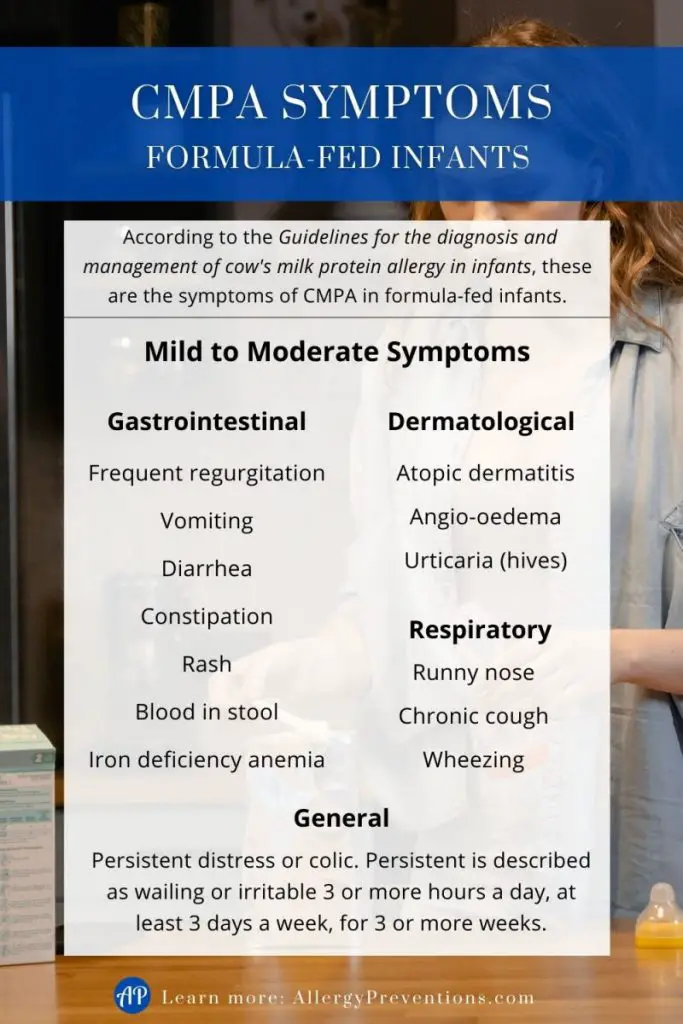
Gastrointestinal
- Blood in stool
- Constipation
- Diarrhea
- Frequent regurgitation
- Iron deficiency anemia
- Rash
- Vomiting
Dermatological (skin)
- Angio-oedema (swelling of lips or eyelids)
- Atopic dermatitis
- Urticaria (hives)
Respiratory
- Chronic cough
- Runny nose
- Wheezing
General
Persistent distress or colic. Persistent is described as wailing or irritable 3 or more hours a day, at least 3 days a week, for 3 or more weeks.
Severe Symptoms in Formula-Fed Infants
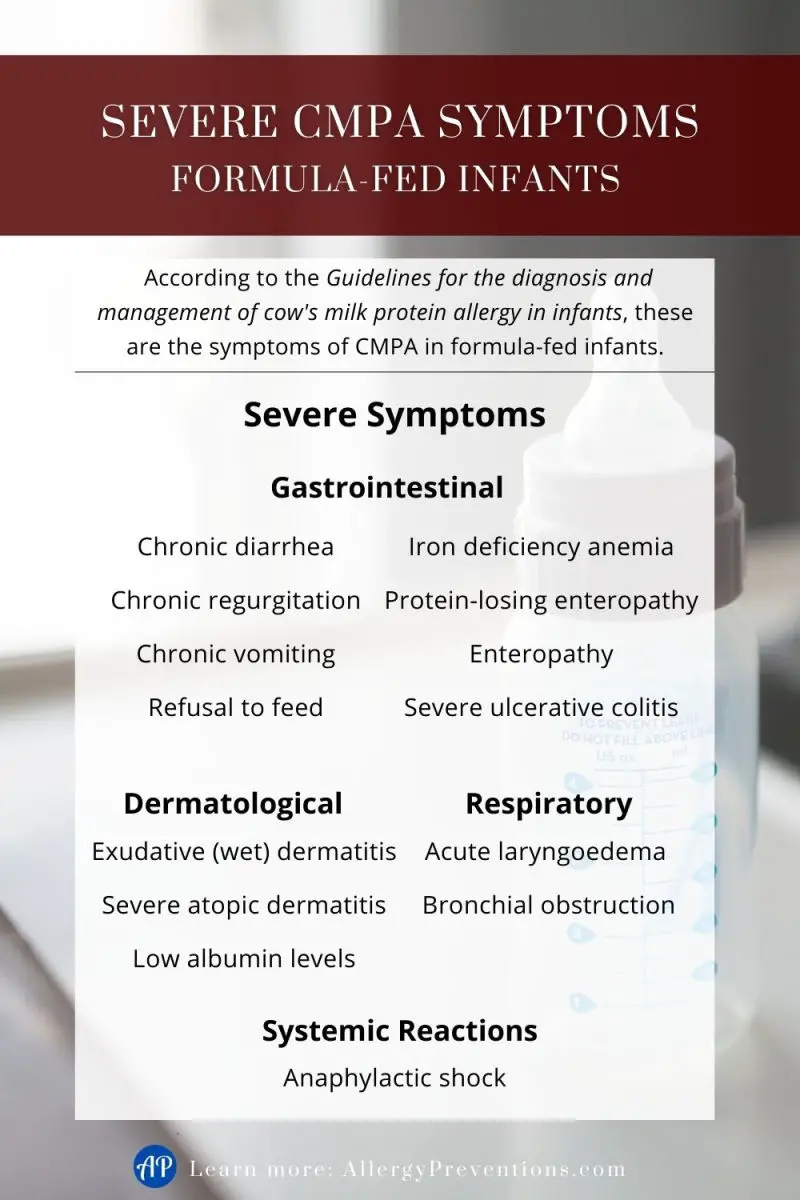
The severe symptoms are similar to the mild to moderate, but also include “Failure to Thrive”. According to Hopkins Medicine, Failure to Thrive is when the child’s weight or rate of weight gain is significantly below that of other children of similar age and sex. Here is a list of possible severe CMPA allergy symptoms in formula-fed infants:
Gastrointestinal
- Chronic diarrhea
- Chronic regurgitation
- Chronic vomiting
- Enteropathy
- Iron deficiency anemia
- Protein-losing enteropathy
- Refusal to feed
- Severe ulcerative colitis
Dermatological (skin)
- Exudative (wet) dermatitis
- Hypoalbuminaemia-anaemia (low albumin protein levels)
- Severe atopic dermatitis
Respiratory
- Acute laryngoedema (larynx swelling)
- Bronchial obstruction
Systemic Reactions
- Anaphylactic shock
If your child has or you suspect has CMPA, and they have any symptoms, take them to a doctor. If the symptoms are severe or seem life-threatening in any way, get emergency medical help right away.
CMPA Allergy Rash
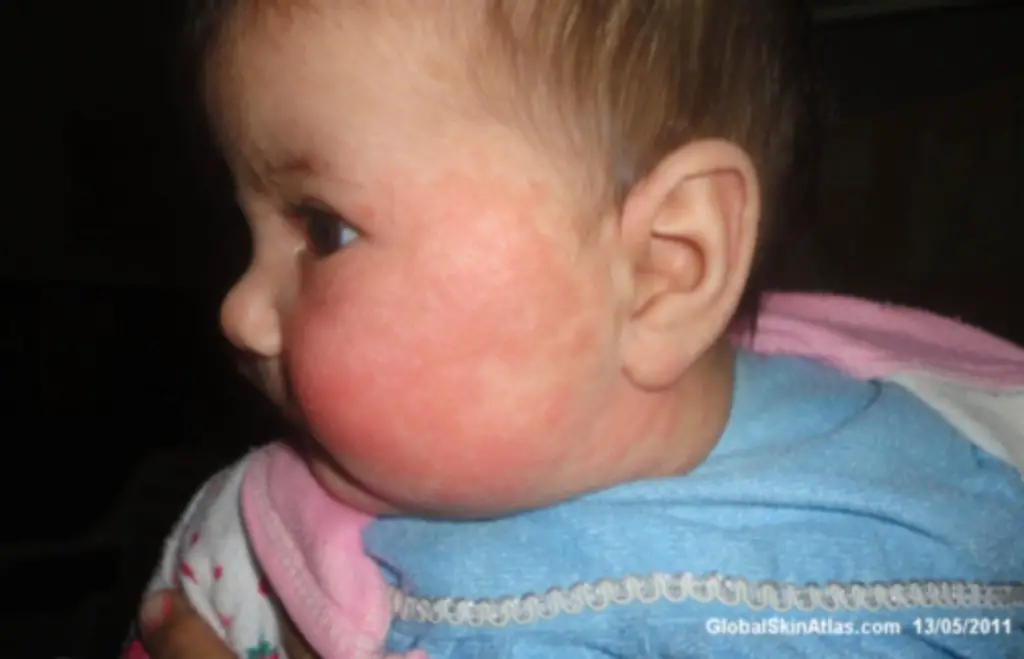
The CMPA rash typically appears as red, itchy patches on the skin. It may be localized to specific areas or spread across larger areas of the body and is typically seen with newborn babies. The rash can be accompanied by other symptoms such as hives, swelling, or eczema flare-ups.
It’s important to note that the CMPA rash can vary in severity and presentation from person to person. Some individuals may experience mild rashes that resolve on their own, while others may have more persistent and severe skin reactions.
CMPA Allergy Rash Images
These images are of children who have been diagnosed with atopic dermatitis from CMPA. Review these cow’s milk protein allergy pictures to get a better understanding of this condition.
CMPA Rash on Baby’s Face
This baby has a rash on her face, specifically on both cheeks. Typically, this is what a cow’s milk protein allergy looks like.
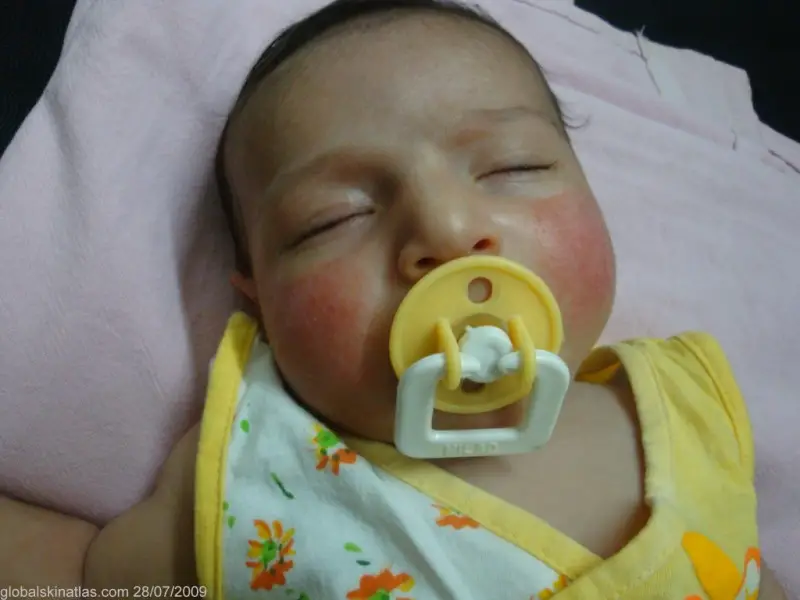
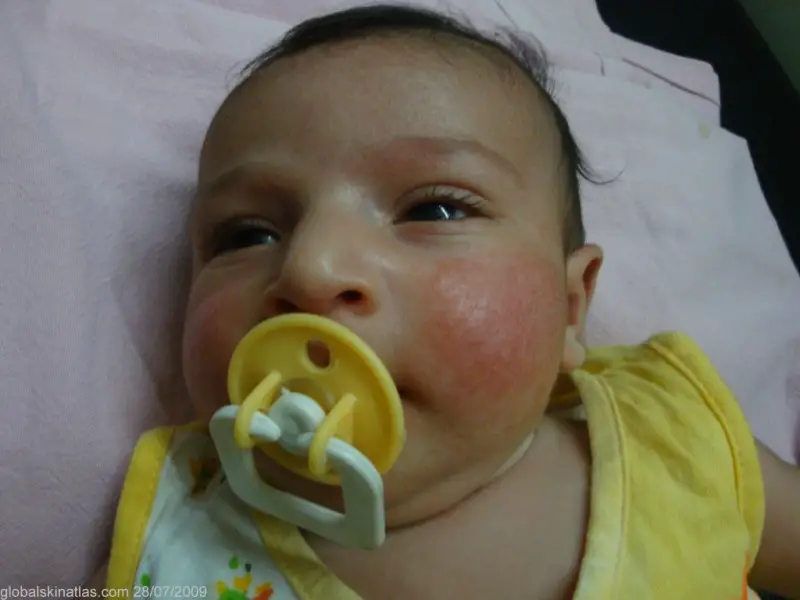
CMPA Rash Spreading
This child is experiencing a rash caused by CMPA on their chin, and both cheeks. The rash looks like it is spreading further up their face.

Baby with Cow’s Milk Protein Allergy Rash
This image shows a CMPA-related rash on the baby’s left cheek. This rash has some scabs, most likely caused by scratching.
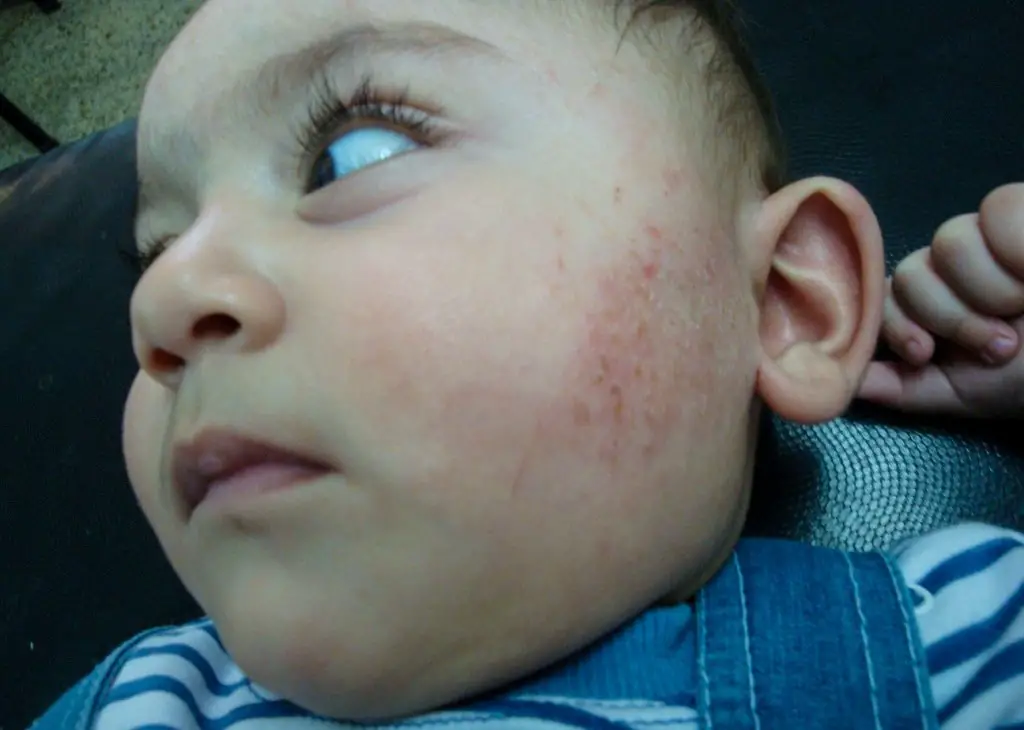
Mild to Moderate CMPA Rash Image
This child has a rash caused by CMPA allergy on both sides of his face. This rash looks, red, dry, and itchy.
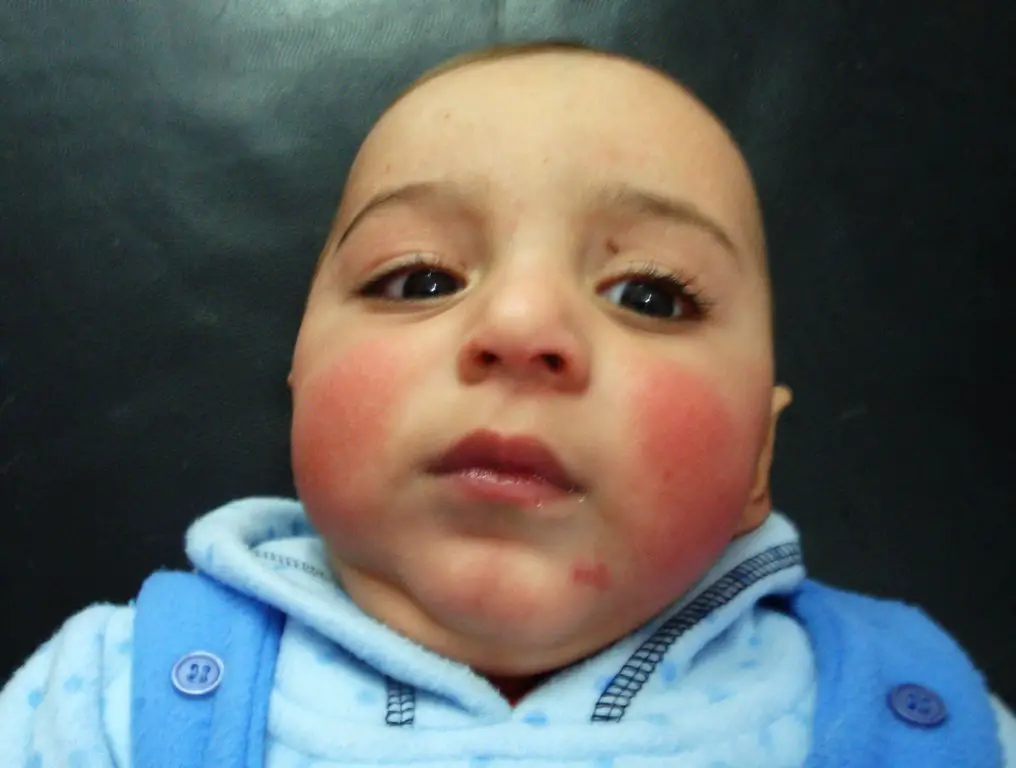
How CMPA is Diagnosed

If you suspect your child has CMPA allergy, the first step is to schedule an appointment with your pediatrician. They will likely refer you to an allergist for further testing. There are two main types of tests used to diagnose CMPA: skin tests, and blood tests.
Skin Test
The skin prick test (SPT) involves placing a drop of cow’s milk protein extract on the skin and then making a small puncture in the skin (usually the back or forearm) so that the allergen can enter. If your child is allergic, they will typically develop a wheal (a raised, itchy bump) within 15 – 20 minutes.
Blood Test
Blood tests are also used to diagnose CMPA. These tests measure the levels of Immunoglobulin E or IgE antibodies in the bloodstream. These antibodies or immune system cells are responsible for allergic reactions. High levels of IgE may indicate an allergy.
Treatment Options for CMPA Allergies
The primary treatment for cows’ milk protein allergy is complete avoidance of cow’s milk and products containing it. Infants with a CMPA allergy may require specialized hypoallergenic formulas as an alternative to cow’s milk-based formulas. In cases where accidental exposure occurs or for severe allergic reactions, emergency medications like antihistamines or epinephrine may be necessary.
